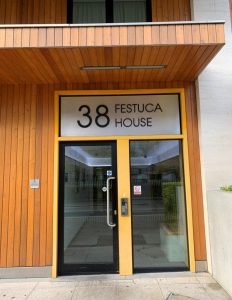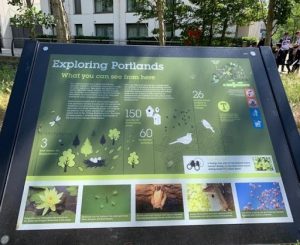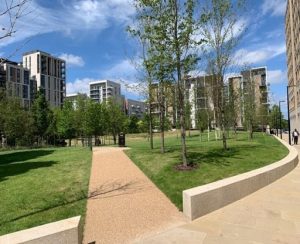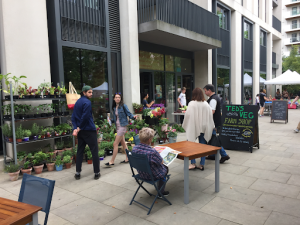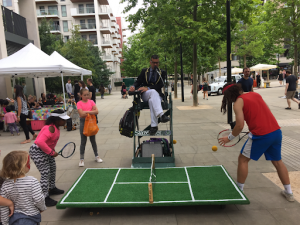By Leon Rosa Reichle
PhD Candidate, Centre for Urban Research on Austerity, DeMontfort University, Leicester UK
My PhD research was interrupted by a pandemic. In this blogpost, I reflect on how my fieldwork in Leipzig, Eastern Germany, is changing due to the outbreak of COVID-19 and according social and political restrictions in April 2020.
The third research phase of my project dedicated to understanding how tenants’ relations change in a restructuring city, happened to be interrupted by a pandemic, that disrupts not just global economic production, but also the entire modes of social reproduction (in homes and communities) (Harvey, 2020; Mezzadra, 2020). The respective state of emergency with curfews, strict rules on social distancing, the stopping of entire industries and daily shift of discourses and emotions towards the spreading pandemic, affects not only my practical fieldwork, but also my subject of analysis. Observers from different places in the world witness different relational manifestations of the disease; economic polarization, the stratification of safety, fear and egoism as well as smiles and new ways of socializing, caring and expressing community (Bude, 2020; Harvey 2020; Mezzadra, 2020; Sennett, 2020). Witnessing a historical and completely unplannable moment in time, I am dedicating this research phase to witnessing how tenants’ relations change in a restructuring city in pandemic times.
Departing from my previous research on a restructuring neighbourhood in which current developments exacerbate post-shrinkage processes of the post-socialist city of Leipzig, this research phase should explore existing and emerging tenants’ relations in a state of emergency. I use my preliminary analysis of Post-Shrinkage-Dialectics as a description of economic and geo-political patterns of urban restructuring in Leipzig before the outbreak of COVID-19. In this context of departure, I have gathered initial findings on tenants’ experiences of urban restructuring in daily life, both within the own home, and within the neighbourhood. My understanding tenants’ perception of their role in the process of restructuring, is so far quite limited. The pre-COVID-19 data gives some glimpses at tenants’ self-perception through reactions to experiences within the home and indicates that the perception of their role in restructuring in the wider neighbourhood is strongly mediated by emerging and existing relations.
The current research phase was initially intended to provide an in-depth analysis of tenants’ perception of their role in urban restructuring – in their flats and in their neighbourhood; defining and analysing existing and emerging tenants’ relations in this context of restructuring and illuminating how existing relations of solidarity and divisions/exclusions between tenants mediate their experience of and relational reaction to urban restructuring and urban society. What changes now, is that another independent variable, an external influence has made its appearance: the outbreak and spreading of COVID-19 and the respective regulations of all social interaction. This requires a revisiting of a previous analysis of experiences of urban restructuring: How are experiences of urban restructuring manifesting under a state of pandemic exception? Furthermore, all following research questions will be adapted: How do tenants perceive their role in urban restructuring during pandemic times? What types of tenants’ solidarities and divisions are existent and emerging on a micro- and meso level in a politically polarized city during pandemic times? Why and how do relations emerge in this moment? How do existing relations change with polarized and selective physical proximity during the pandemic? And: How do existing relations and divisions (before COVID-19) mediate their pre-COVID-19 and current experience of (and relational reaction to) urban restructuring?
Experiences of Urban Restructuring
Most experiences of urban restructuring that have come up in my research so far, have been related to different forms of displacement: few cases of direct displacement, exclusionary displacement either causing people to either be stuck in (partly unfavourable) conditions, or leading to segregation and polarization, related anxieties and pressure caused often by neglect. Whereas direct displacements are officially paused by the German Government currently, and tenants are legally enabled to postpone their rent payments (tagesschau 2020), this will undoubtedly lead to piling up of rental debt for some tenants. How does this affect feelings of security versus anxiety and pressure? How does it affect relations to landlords and other tenants?
The consequences of exclusionary displacement might materialize to a more drastic extent now, that leaving the house is highly regulated and limited. What are the consequences of a quasi-curfew for families in overcrowded flats? For seniors in too large flats? How do tendencies of segregation mediate the experience of the curfew? To what extent are distancing, isolation, shielding and quarantine feasible, and for whom? And lastly, living in (strategically) neglected housing could become much more noticeable in times, where more time than ever is spent at home. How do quarantine and curfew influence the experience of neglected housing?
Tenants’ solidarities and divisions
An open-ended list of existing and emerging relational goods and evils (Donati, Archer, 2015) so far entails: friendly encounters; friendships; a dense network of institutional neighbourliness; Hausgemeinschaften (house-communities); mutual help networks on the side of relational goods; the analogy with a village somewhere between a relational good and evil, and an increasing lack of time and space; territorial stigma and racism; competitive racism; language barriers between tenants; shame; a history of denunciation; generational changes hand in hand with fluctuation and anonymization; (resulting) loneliness; conflicts between long-term tenants and newcomers and competing economic interests of different tenants on the side of relational evils.
Some of these might be directly mediated by the outbreak and spreading of COVID-19 and/or the resulting restrictions of social life. How does a network of institutional neighbourliness react to a pandemic and with what effects? How do house-communities change? Which mutual help networks change, break or emerge? Does territorial stigma and different forms of racism interplay with the disease at all? How are language barriers reinforced or overcome? How is the lack of time and space changing? What role does shame play these days? Does a history of denunciation mediate people’s response to the pandemic? Which role do generational changes in the neighbourhood play now and are the divisions resulting from fluctuation and anonymization exacerbated, continued or overcome? How is loneliness changing, increasing or interrupted and with what consequences? How do conflicts between long-term tenants and newcomers mediate relations in the neighbourhood now? How do they influence the efficiency of self-help networks? Can they be overcome? And lastly: how do different economic interests play out in the entire scenario? This is just an incipient list of questions resulting from the current material, but it will be inductively sorted, tidied out and complemented with the messy material that is bound to come up in the following weeks.
My research project has a strong focus on temporality defined by its main question on change, disruption and emergence. Now it is complemented with an unexpected, very distinct temporal marker, which might turn out to indicate radical change, continuity, reinforcement or breaks – for the world and for housing relationships in a restructuring city.
Methods
Methodologically, my research project is based on the critical realist principle of retroduction (Belfrage, Hauf, 2017), which indicates both a research motivation of producing critical knowledge on an observed social problem, and a specific practice of research. The practice describes a spiral from de- to induction and back and forth again, hence from theoretical deskwork and initial critical sensitizing theories to open-minded fieldwork and from there on back and forth between fallible existing theories, inductive analysis and theory building. As a supportive friend in my feminist colloquium reminded me in a state of slight panic over the consequences of COVID-19 for the world and my research, this research practice is ideal for my situation, as it permits me to embrace the changing priorities in the field and analyse them critically to complement existing theories.
Yet whereas my research design usually envisages a careful planning of each following state of fieldwork following the analysis of the previous one, this historical moment of potential constant change and unforeseeable consequences demands a certain flexibility and messiness. The following outlines a brief research design which is likely to undergo changes every day. Initially, this research phase designed to conduct interviews and focus group discussions with different types of tenants rendered socially or economically vulnerable. I have classified these so far into financially precarious students or young academics (a); unemployed or working poor long-term residents – of which many are or are becoming “key workers” (b); elderly or retired tenants (c); and tenants with a biography marked by international migration (d).
The biggest challenge of my research under a pandemic state of exception, besides not being able to physically meet people, is just an exacerbation of a general challenge: a lack of existing relationships, which now is much harder to overcome, as physical spaces of encounter are minimized. This permits two practical consequences: using existing relations for research and finding creative methods to build new ones.
Building on existing relations…
… Permits me to reschedule planned interviews as phone interviews and have casual conversations over the phone. This will be my first method. Considering the relations, I already have, this permits me access to tenants of different groups:
(a) financially precarious students and young academics – through my personal friend- and activist networks in the neighbourhood, the access to students is quite easy.
(c) elderly or retired tenants – luckily, a time-line focus group with retired tenants physically took place just before the outbreak of COVID-19. I am now in direct contact with social workers in a seniors’ social centre and have put up a small notification on the website of the centre with my phone number and some lines on my research. Additionally, I have been included on a phone-chain initiated by the centre, meaning that I might be called once or twice per week by an unknown senior tenant informing me on their physical and emotional situation and needs and passing the call on to another elderly tenant. This could be a promising example of emerging neighbourhood relations. Outside of this network, I am planning to ask other future interview partners for contacts to elderly tenants in their houses.
(d) tenants with a biography marked by international migration – potentially, after rescheduling a group interview with three social workers working in different neighbourhood centres from and for international girls and women into a video-call group interview, I could find ways to talk to tenants with a migration-biography. Yet here, I imagine language to be an even bigger barrier, then in person. I will keep this open thread in mind.
… Has encouraged phone conversations with befriended activists in a variety of neighbourhood-initiatives, which then in turn have tilted my intention to not engage in activist scholarship during my PhD. As a result of the current state of exception, I have organized a video conference to discuss the political implications, consequences and chances of the current moment for neighbourhood organizing. A second meeting is about to follow.
… Permits me to engage in virtual spaces, that I already have access to. This mainly centres around chat groups in my neighbourhood. An existing one is “sharing is caring East”, where currently 5765 people are discussing and sharing random stuff. Furthermore, several self-help groups and channels have emerged. I believe, that in terms of groups of interest, these are mainly used by (a) students and young academics. I am already engaging and in a process of participant observation in these groups and have used one of them to advertise the video conference. They can be both spaces to find new interview partners and potential connecting points for further discussion and organizing.
… Has, so far, permitted me to talk to my neighbours both just before and right after my recent move. In both houses many tenants are (b) unemployed or working poor long-term residents, with whom I have had and still have chats (with safe distance) when we meet in the hallways, or when I offered them support for shopping. In my old house I put up my phone number, in case somebody gets quarantined and needs help. So far, I have engaged in informal conversations with old and new neighbours and it is uncertain how these will continue.
Finding creative methods to build new relations…
… Is something I have started diving into, as my contact to (b) unemployed or working poor long-term residents is limited. A means of communication that is currently spreading quickly in the neighbourhood is written communication. Little posters, notes and signs, on doors of supermarkets, residential houses, lanterns complement posters by the city, online adverts for governmental information on COVID-19 and newspapers releasing daily updates. They contain advice, help-offers, cheery messages, translations of the new legal restrictions, scientific information and so on. I have decided to join into this method of communicating, hence also testing how well it works, through posting 100 letters with an invitation to a phone call in randomized letter boxes. My current knowledge on the neighbourhood permitted me to make a rough selection of houses worth considering within certain areas, based on rent prices (and landlords), the state of buildings, previous statements of interviewees and everyday observations. This selection raises the probability of reaching tenants that rely on transfer-incomes, as this determines where people can still afford to live (KDU-segregation). So far, I have received 3 calls from tenants, resulting in short semi-structured interviews, roughly following a previously prepared schedule. In one case this interview permitted me to snowball to another interviewee.
Ethnography
As before, all these methods will be complemented by a critical ethnography of neighbourhood life. This can contain walks, excursions to the supermarkets and online (chat group) observations. Probably the best way to keep track of the constantly shifting circumstances, and maintaining a distance to the field, is a continuous dedication to writing field notes.
Literature
Bude, H. (2020) Die Leute passen aufeinander auf. Frankfurter Rundschau, 18 Mar.
Donati, P. and Archer, M.S. (2015) The Relational Subject. Cambridge: Cambridge University Press.
Harvey, D. (2020) ANTI-CAPITALIST POLITICS IN THE TIME OF COVID-19 (Revised version, March 22, 2020). [Online] Urban Front. Available from : https://www.urban-front.com/articles [Accessed 23/03/20].
Mezzadra, S. (2020) Eine Politik der Kämpfe in Zeiten der Pandemie. [Online] de.indymedia.org. Available from : https://de.indymedia.org/node/72570 [Accessed 25/03/20].
Sennett, R. (2020) „Wir müssen wachsam sein“. tagesspiegel, 19 Mar.
tagesschau (2020) Corona-Krise: Regierung plant Schutzmaßnahmen für Mieter. [Online] tagesschau.de. Available from : https://www.tagesschau.de/inland/miete-corona-101.html.

